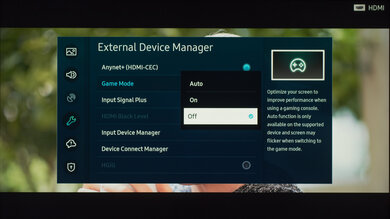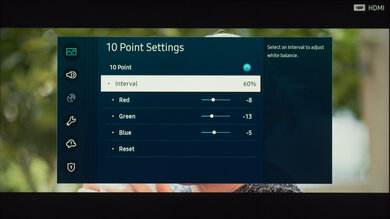We used the following calibration settings to review the 77 inch Samsung TU6980 (UN70TU6980FXZA), and we expect them to be valid for the 82" model (UN82TU6950FXZA) as well. These settings should apply to most types of content, except for gaming or use as a PC monitor, which require a few additional changes, listed below.
General Settings
Eco Settings
One of the first things we did was disable all of the Eco Solution options, as we don't want the TV to adjust the image during testing.
SDR
For SDR content, there are five preset picture modes. We recommend choosing the 'Movie' picture mode, as it is the most accurate one out of the box, and allows for the most customization. From the Expert Settings menu, we recommend leaving the Contrast at '45,' and Sharpness at '0.' We also left Color at the default value of '25,' and Tint (G/R) at '0.' Finally, we chose the 'Warm2' Color Tone, as it was closest to our calibration targets. We set the Gamma to '2.2,' as that is closest to our calibration target.
To make the image brighter in SDR, you should adjust the Brightness setting depending on your specific viewing conditions. Changing this setting does not have any impact on the overall picture quality. Samsung has renamed the 'Backlight' setting found on previous generations and removed the previous Brightness setting.
Image Enhancements
As we aim for an image that is as close as possible to the content creator's intent, we disable most image processing options, including Digital Clean View, Picture Clarity, and Contrast Enhancer. You should adjust these to your personal preference though.
HDR
HDR is automatically enabled for the native apps. When you start playing HDR content, a small HDR icon appears next to the picture mode on the quick settings menu. Once you start playing HDR content, some of the settings change automatically, including the Brightness, which increases to 'Max.' We recommend leaving these settings to their default settings in HDR.
For HDR to work from external devices, Input Signal Plus usually has to be enabled from the External Device Manager menu for the input you are using. Older devices may have compatibility issues if this option is left enabled, so it is recommended to only enable this setting for devices that require it.
If you find HDR too dim and want a brighter image, set the Contrast Enhancer to 'High', ST.2084 to '+3', Tone Color to 'Cool', and Brightness and Contrast at their max in the 'Movie HDR' Picture Mode. This results in a brighter image, as you can see in this EOTF.
Motion Settings
Although we disable most motion enhancing functions for most of our tests, you should adjust these to whatever looks best for you. Some settings may need to be adjusted depending on the specific content you are watching.
Motion Interpolation
Although we usually leave these settings disabled during most of our testing, you should adjust the settings in the Picture Clarity Settings menu to your liking, as different people prefer different levels of motion interpolation. If you want to enable motion interpolation, set Picture Clarity to 'Custom,' and adjust the Judder Reduction slider to '10' for low-frame rate content, like Blu-Ray movies. The LED Clear Motion setting controls this TV's Black Frame Insertion feature. Most of these settings will need to be adjusted depending on the specific content you are watching.
Judder
This TV automatically removes judder from native 24p sources, such as native apps or Blu-ray players. For it to work, simply disable Picture Clarity.
Gaming
From the base SDR and HDR settings, very few changes are required for a great gaming experience. When you start gaming, it is best to enable Game Mode from the General settings tab to get the lowest input lag and use the recommended settings for SDR or HDR. For HDR gaming, it is important to make sure that Input Signal Plus is enabled for the input you are using.
PC Gaming
This TV will usually detect when it is connected to a PC, and will automatically enter PC mode, to ensure proper chroma 4:4:4 support. You can also manually enable PC mode by changing the input icon to 'PC.' In PC mode, some settings are disabled, including many picture settings, and there are only two Picture Modes: 'Standard,' and 'Dynamic.' For low input lag in 'PC' mode, Game Mode must also be enabled.
Other Settings
Screen Settings
When watching lower resolution content, the upscaling method may need to be adjusted depending on the specific format. The screen position, zoom, and picture size can be adjusted from the Picture Size Settings sub-menu. During testing, we encountered a bug when in PC mode, where the image would be zoomed in too much. Entering and leaving the menu would correct the zoom.
White Balance Settings
The following are the results of the white balance and colorspace calibration on our unit. They are provided for reference, and should not be copied as the calibration values vary per individual unit even for the same model and same size as the TV we reviewed due to manufacturing tolerances. If you want to try them you will need to enter all values shown, as all of them are active at the same time. If you end up with worse picture quality, simply reset them to the default values.










































































